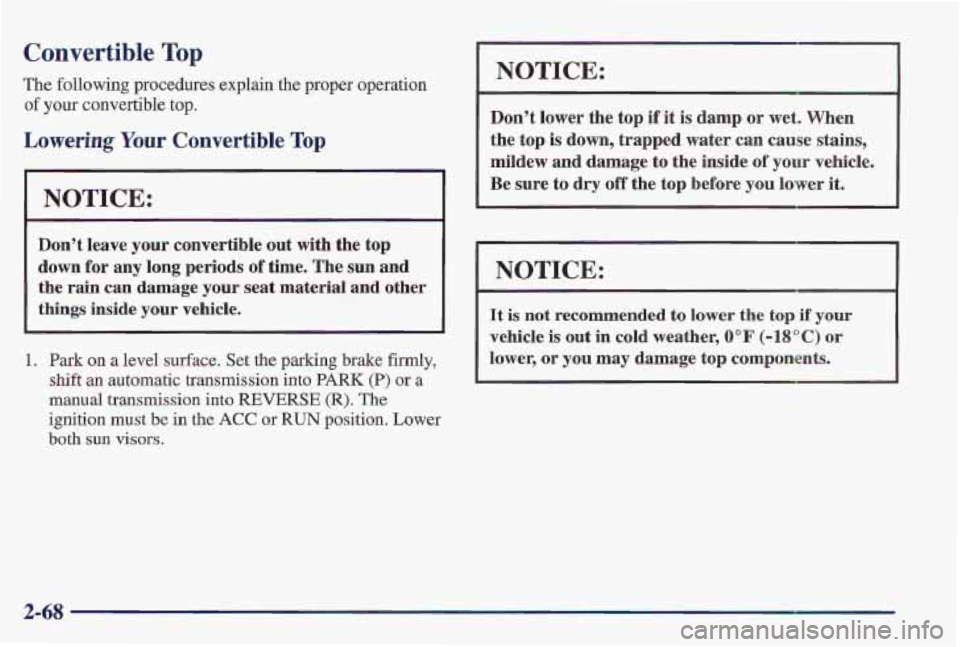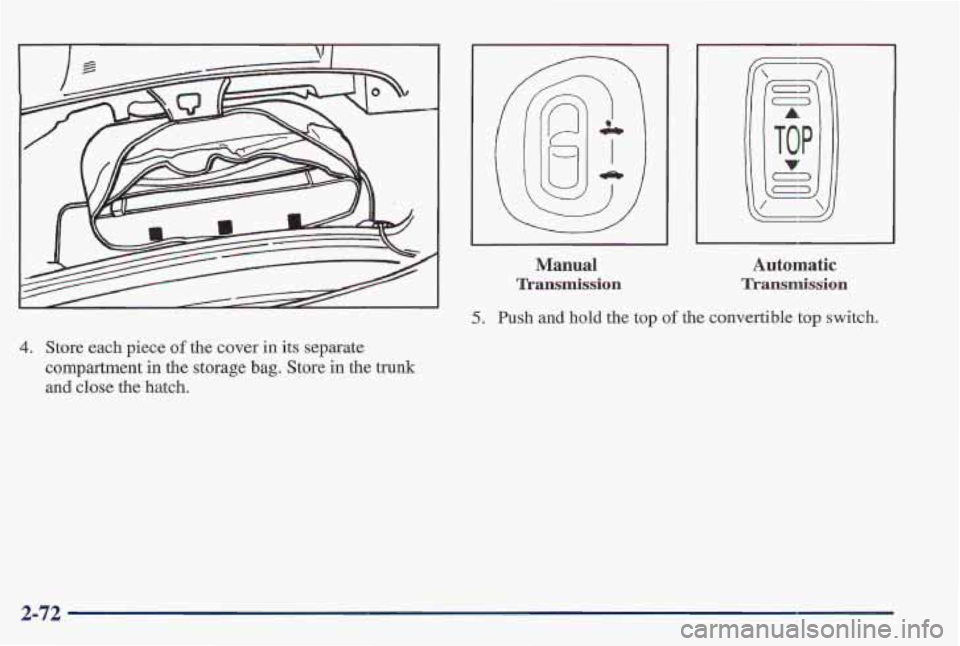automatic transmission PONTIAC FIREBIRD 1997 User Guide
[x] Cancel search | Manufacturer: PONTIAC, Model Year: 1997, Model line: FIREBIRD, Model: PONTIAC FIREBIRD 1997Pages: 410, PDF Size: 19.2 MB
Page 88 of 410

2.
3.
4.
Hold the brake pedal down with your right foot and
set the parking brake.
Move the shift lever
into PARK (P) position by
holding in the button
on the lever and pushing the
lever all the way toward the front
of your vehicle.
Move the ignition key to
LOCK.
Remove the key and take it with you. If you can
leave your vehicle with the ignition key in your
hand, your vehicle is in PARK (P).
Leaving Your Vehicle With the Engine
Running (Automatic Transmission
Models Only)
It can be dangerous to leave your vehicle with the
engine running. Your vehicle could move
suddenly
if the shift lever is not fully in PARK (P)
with the parking brake firmly set. And, if you
leave the vehicle with the engine running,
it could
overheat and even catch fire. You
or others could
be injured. Don’t leave your vehicle
with the
engine running unless you have to.
2-39
Page 89 of 410

Torque Lock (Automatic Transmission)
If you are parking on a hill and you don’t shift your
transmission into
PARK (P) properly, the weight of the
vehicle may put too much force on the parking pawl in
the transmission.
You may find it difficult to pull the
shift lever out of
PARK (P). This is called “torque lock.”
To prevent torque lock, set the parking brake and then
shift into PARK
(P) properly before you leave the
driver’s seat.
To find out how, see “Shifting Into PARK
(P)” in the Index.
When you are ready to drive, move
the shift lever out of
PARK (P) before you release the parking brake.
If torque lock does occur, you may need to have another
vehicle
push yours a little uphill to take some of the
pressure from the parking pawl in the transmission,
so
you can pull the shift lever out of PARK (P).
Parking Your Vehicle
(Manual Transmission)
Before you get out of your vehicle, put your manual
transmission in REVERSE (R) and firmly apply the
parking
brake.
If your vehicle is equipped to tow a trailer, see “Towing
a Trailer” in the Index,
Shifting Out of PARK (P)
(Automatic Transmission)
Your Pontiac has a brake-transmission shift interlock.
You have to fully apply your regular brake before you
can shift from PARK
(P) when the ignition is in the
RUN position.
See “Automatic Trans---’ssion” in
the Index.
If you cannot shift out of PARK (P), ease pressure on
the shift lever
-- push the shift lever all the way into
PARK (P) and release the shift lever button as you
maintain brake application. Then press the shift lever
button and move the shift lever into the gear you wish.
If you ever hold the brake pedal down but still can’t
shift out of PARK (P),
try this:
1. Turn the key to OFF.
2. Apply and hold the brake.
3. Shift to NEUTRAL (N).
4. Start the vehicle and then shift to the drive gear
you want.
5. Have the vehicle fixed as soon as you can.
2-40
Page 91 of 410

Running Your Engine While You’re
Parked (Automatic Transmission)
It’s better not to park with the engine running. But if you
er have to, here are some things.. .fl,.:?=....v,> tg kngw,. ,:+:-., i::, ,..>?pd; y.
Idling the engine with the air system control off
could allow dangerous exhaust into your vehicle
(see the earlier Caution under <‘Engine Exhaustss),
Also, idling in
a closed-in place can let deadly
carbon monoxide (CU) into your vehicle even if
the fan switch is
at the highest setting. One place
this
can happen is a garage. Exhaust -- with
CO -- can come in easily. NEVER park in a
garage with the engine running.
Another closed-in place can be
a blizzard, (See
“Blizzard” in the Index.)
A CAUTION:
It can be dangerous to get out of your vehicle if
the shift lever
is not fully in PARK (P) with the
parking brake
firmly set, Your vehicle can roll.
Don’t leave your vehicle when the engine is
running unless you have to. If you’ve left the
engine running, the
vehicle can move suddenly.
You
or others could be injured. ‘Bo be sure your
vehicle won’t move, even when you’re on fairly
level ground, always set your parking brake and
move the shift PWW to P;ARK (P).
Follow the proper steps to be sure your vehicle won’t
move. See “Shifting Into PARK (P)” in the Index.
If you are parking on a hill and if you’re pulling a
trailer, also see “Towing a Trailer” in the Index.
2-42
Page 108 of 410

When carrying large or heavy items, it is a good idea to
open the panel and place the items in the rear area.
I An improperly stored close-out panel could be
thrown about the vehicle during
a collision or
sudden maneuver. You
or others could be
injured. If you remove the cover, always store it
outside your vehicle. When you put it back,
always be sure that it is securely reattached.
Ashtray and Lighter
Lift up the cover to open the ashtray. To remove it, lift
up on either side
of the ashtray. If you have an automatic
transmission, the ashtray
is near the front of your
console.
If you have a manual transmission, the ashtray
is near your cupholder.
I NOTICE:
Don’t put papers and other things that burn into
your ashtray.
If you do, cigarettes or other
smoking materials could set them on
fire,
causing damage.
To use the lighter, push it in all the way and let go.
When it’s ready, it will pop back by itself.
2-59
Page 117 of 410

Convertible Top
The following procedures explain the proper operation
of your convertible top.
Lowering Your Convertible Top
NOTICE:
Don't leave your convertible out with the top
down for any long periods 'of time. The sun and
the rain can damage your seat material
and other
things inside your vehicle.
1. Park on a level surface. Set the parking brake firmly,
shift an automatic transmission into PARK (PI or a
manual transmission into REVERSE (R). The
ignition must be in the ACC or RUN position. Lower
both sun visors.
NOTICE:
Bun% lower the top if it is damp 'or wet. When
the
top is down, trapped water can cause stains,
mildew and damage to the inside of your vehicle.
Be sure to
dry off the top before you lower it.
NOTICE:
It is' not recommended to lower the top if your
vehicle
is out in cold weather, 0°F (-18" C) or
lower, or you may damage top components.
2-68
Page 118 of 410

~~~~ Manual
Transmission
I NOTICE:
Before lowering the convertible top into the
storage area, be sure there are no objects in the
way of the folded, stored top. The weight of a
stored top
on items in the storage area will cause
the convertible top back glass
to break.
2. Unlock the front of the convertible top by pushing on
the smaller
part of the latch, then pulling down on the
larger
part of the latch. Be sure the hook on the latch
that attaches into the hole at the windshield releases.
Automatic
Transmission
3. Be sure no one or nothing is on or around the top.
Push and hold the bottom of the convertible top
switch. The switch is on the left side of your console
for a manual transmission and in front
of the gear
shift lever for automatic transmissions. The
top will
automatically lower into the storage area.
Page 120 of 410

Raising Your Convertible Top
1. Park on a level surface. Set the parking brake firrnly.
If you have an automatic transmission, shift into
PARK
(P). If you have a manual transmission, shift
into REVERSE (R). The ignition must be in the ACC
or RUN position or RAP must be on. Lower both sun
visors. Lower both windows at least
3 inches (8 cm). If
the boot cover is in place, it must be removed first.
3. Remove the two side pieces of the boot cover
by lifting the rear cover and sliding them out
of
their slots.
2. Open the trunk. Remove the middle piece of the
cover by pushing in on the latch and lifting up on
the cover.
Page 121 of 410

4. Store each piece of the cover in its separate
compartment
in the storage bag. Store in the trunk
and close the hatch.
Manual
7lkansmission
~~~ ~
Automatic
Transmission
5, Push and hold the top of the convertible top switch.
2-72
Page 124 of 410

A. Fog Lamp Switch (If Equipped)
B. Main Lamp Control
C. Air Vent
D. Instrument Cluster
E.
Horn
E Audio System
G. Glove Box
H. Comfort Controls
I. Cupholder
J. Parking Brake Lever
K.
Storage Console
L. Rear Window Defogger Switch
M. Convertible Top Switch (Automatic) (If Equipped)
N. Traction Control System Switch or Second Gear
0. Cigarette Lighter
P. Shift Lever
Q. Ashtray (Automatic Transmission)
R. Convertible Top Switch (Manual) (If Equipped)
S. Steering Wheel Controls
T. Remote Hatch Release
Start
Switch (If Equipped)
Page 202 of 410

Driving On Grades Making Turns
I NOTICE:
Making very sharp turns while trailering could cause the trailer to come in contact with the
vehicle. Your vehicle could be damaged. Avoid
making very sharp turns while trailering.
When you’re turning with a trailer, make wider turns than
normal. Do
this so your trailer won’t strike soft shoulders,
curbs, road signs, trees or other objects. Avoid jerky or
sudden maneuvers. Signal well in advance.
Turn Signals When Towing a nailer
The green arrows on your instrument panel will flash
whenever you signal a turn or lane change. Properly
hooked up, the trailer lamps will also flash, telling other
drivers you’re about to turn, change lanes or stop.
When towing a trailer, the green arrows on your
instrument panel will flash for turns even if the bulbs on
the trailer are burned out. Thus, you may think drivers
behind you are seeing your signal when they are not. It’s
important to check occasionally to be sure the trailer
bulbs are still working. Reduce
speed and shift
to a lower gear before you start
down a long or steep downgrade. If you don’t shift
down, you might have to use your brakes
so much
that they would get hot and
no longer work well.
On a long uphill grade, shift down and reduce your
speed to around
45 mph (70 km/h) to reduce the
possibility
of engine and transmission overheating.
If you are towing a trailer and you have an automatic
transmission with overdrive, you may prefer to drive in
THIRD
(3) instead of AUTOMATIC OVERDRIVE (a)
(or, as you need to, a lower gear). Or, if you have a
manual transmission with FIFTH
(5) or SIXTH (6) gear
and you are towing a trailer, it’s better not to
use FIFTH
(5) or SIXTH (6) gear. Just drive in
FOURTH
(4) (drive in FIFTH (5) if you have a
six-speed manual transmission) or, as you need to,
a lower gear.
4-37